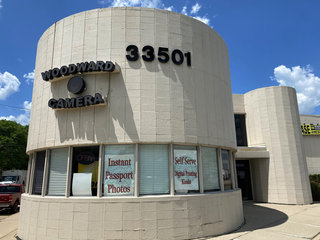On my 20th birthday, I asked my father for a camera. I was home in Detroit after my first year at university in Boston that would be my last. The request for a camera did not come out of nowhere. I had hated high school- classrooms, structure. I loved field trips, reading literature, making maps in geography class, looking at photographs in encyclopedias, cutting pictures out of magazine and making collages. I always assumed photography was not something I could do, that the camera was too technical (I had an instamatic), and in my world, it was something men controlled. It was 1977. I was not empowered in the way that I would become – largely due to photography.
We went to Woodward Camera. The salesman placed camera after camera on the counter and I held each one, raising the viewfinder up to my eye and feeling the weight and balance in my hands. I chose the Pentax K1000, a popular, solid, dependable 35mm camera. Simply, it felt right.
I could not put it down. I found my voice, my instrument of communication, my connection to my creativity, imagination and eventually my activism. The next step was to quit college altogether and attend a photography school in Essex Mass for an intensive 3-month course.
It was a love affair that started when I began to develop my B&W film and print my own pictures. For the first year, I was drawn to the streets and photographing shadows -experimenting with light, exposure and composition. Eventually, I landed a job at the North Shore Weekly Newspaper, followed by my departure to NYC (I was informed it was the center of the photography world), to jobs in darkrooms, in a color lab, in a small photo agency, to my first assignment.
I was in the darkroom at the color lab, listening to public radio talking about an upcoming demonstration in Wash D.C. called The Women’s Pentagon Action. Thousands of women would be encircling the Pentagon, doing civil disobedience in a massive protest against the escalation of the nuclear arms race. I knew I needed to be there. I called Newsweek Magazine and asked to speak to the photo editor, and they actually connected me. I described what was to take place and strongly suggested that he hire me to be there. Shockingly, he agreed. A week later I was on the train to DC.
It was there that I fully connected and committed to making images that would shed light on people’s bravery, the magic of activist creativity and the relentless determination to never give up in the face of injustice.
Forty-seven years later, driving up Woodward Ave, I saw that the camera store was still there.

CV:
””:https://drive.google.com/file/d/1tFxqjiyQLuVZx-IVU6XUID_ScIN0gWU8/view?usp=share_link
We went to Woodward Camera. The salesman placed camera after camera on the counter and I held each one, raising the viewfinder up to my eye and feeling the weight and balance in my hands. I chose the Pentax K1000, a popular, solid, dependable 35mm camera. Simply, it felt right.
I could not put it down. I found my voice, my instrument of communication, my connection to my creativity, imagination and eventually my activism. The next step was to quit college altogether and attend a photography school in Essex Mass for an intensive 3-month course.
It was a love affair that started when I began to develop my B&W film and print my own pictures. For the first year, I was drawn to the streets and photographing shadows -experimenting with light, exposure and composition. Eventually, I landed a job at the North Shore Weekly Newspaper, followed by my departure to NYC (I was informed it was the center of the photography world), to jobs in darkrooms, in a color lab, in a small photo agency, to my first assignment.
I was in the darkroom at the color lab, listening to public radio talking about an upcoming demonstration in Wash D.C. called The Women’s Pentagon Action. Thousands of women would be encircling the Pentagon, doing civil disobedience in a massive protest against the escalation of the nuclear arms race. I knew I needed to be there. I called Newsweek Magazine and asked to speak to the photo editor, and they actually connected me. I described what was to take place and strongly suggested that he hire me to be there. Shockingly, he agreed. A week later I was on the train to DC.
It was there that I fully connected and committed to making images that would shed light on people’s bravery, the magic of activist creativity and the relentless determination to never give up in the face of injustice.
Forty-seven years later, driving up Woodward Ave, I saw that the camera store was still there.

CV:
””:https://drive.google.com/file/d/1tFxqjiyQLuVZx-IVU6XUID_ScIN0gWU8/view?usp=share_link